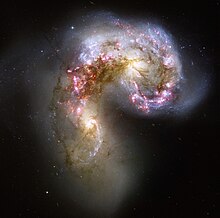NGC 4631 is a barred spiral galaxy in the constellation Canes Venatici about 30 million light years away from Earth. This galaxy's slightly distorted wedge shape gives it the appearance of a herring or a whale, hence its nickname. Because this nearby galaxy is seen edge-on from Earth, professional astronomers observe this galaxy to better understand the gas and stars located outside the plane of the galaxy.

The Leo Triplet is a small group of galaxies about 35 million light-years away in the constellation Leo. This galaxy group consists of the spiral galaxies M65, M66, and NGC 3628.

Messier 94 is a spiral galaxy in the mid-northern constellation Canes Venatici. It was discovered by Pierre Méchain in 1781, and catalogued by Charles Messier two days later. Although some references describe M94 as a barred spiral galaxy, the "bar" structure appears to be more oval-shaped. The galaxy has two ring structures.

The M101 Group is a loose group of galaxies located in the constellation Ursa Major. The group is named after the brightest galaxy in the group, the Pinwheel Galaxy (M101). Most of the other members of the group are companions of the Pinwheel Galaxy. The group itself is one of many located within the Virgo Supercluster.

NGC 4027 is a barred spiral galaxy approximately 83 million light-years away in the constellation Corvus. It is also a peculiar galaxy because one of its spiral arms goes out more than the other. This is probably due to a galactic collision in NGC 4027's past.
The M94 Group is a loose, extended group of galaxies located about 13 million light-years away in the constellations Canes Venatici and Coma Berenices. The group is one of many groups that lies within the Virgo Supercluster and one of the closest groups to the Local Group.
The M74 Group is a small group of galaxies in the constellation Pisces. The face-on spiral galaxy M74 is the brightest galaxy within the group. Other members include the peculiar spiral galaxy NGC 660 and several smaller irregular galaxies . The M74 Group is one of many galaxy groups that lie within the Virgo Supercluster.

The M109 Group is a group of galaxies about 55 million light-years away in the constellation Ursa Major. The group is named after the brightest galaxy within the group, the spiral galaxy M109.
The NGC 4631 Group is a poorly defined group of galaxies, about 25 million light-years from Earth in the Coma Berenices and Canes Venatici constellations.

NGC 3953 is a barred spiral galaxy located in the constellation Ursa Major. The galaxy is known to exhibit an inner ring structure that encircles the bar. NGC 3953 is a member of the M109 Group, a large group of galaxies located within the constellation Ursa Major that may contain over 50 galaxies.

NGC 3384 is an elliptical galaxy in the constellation Leo. The galaxy was discovered by William Herschel in 1784 as part of the Herschel 400 Catalogue. The high age of the stars in the central region of NGC 3384 was confirmed after analysis of their color. More than 80% were found to be Population II stars which are over a billion years old. The supermassive black hole at the core has a mass of 1.6+0.1
−0.2×107 M☉.

The M51 Group is a group of galaxies located in Canes Venatici. The group is named after the brightest galaxy in the group, the Whirlpool Galaxy (M51A). Other notable members include the companion galaxy to the Whirlpool Galaxy (M51B) and the Sunflower Galaxy (M63).

The M96 Group is a group of galaxies in the constellation Leo. This group contains between 8 and 24 galaxies, including three Messier objects. It also contains the Leo Ring. The group is one of many groups that lies within the Virgo Supercluster.

The Coma I Group is a group of galaxies located about 14.5 Mpc (47.3 Mly) away in the constellation Coma Berenices. The brightest member of the group is NGC 4725. The Coma I Group is rich in spiral galaxies while containing few elliptical and lenticular galaxies. Coma I lies in the foreground of the more distant Coma and Leo clusters and is located within the Virgo Supercluster.

NGC 3981 is an unbarred spiral galaxy located 62 million light-years away in the constellation of Crater. It was discovered on February 7, 1785 by William Herschel.

NGC 668 is a spiral galaxy located 200 million light-years away in the constellation Andromeda. It was discovered by astronomer Édouard Stephan on December 4, 1880 and is a member of Abell 262.

NGC 669 is an edge-on spiral galaxy with an active galactic nucleus located 200 million light-years away in the constellation Triangulum. NGC 669 was discovered by astronomer Édouard Stephan on November 28, 1883 and is a member of Abell 262.

NGC 4221 is a barred lenticular galaxy located about 75.9 million light-years away in the constellation of Draco. It was discovered on April 3, 1832, by the astronomer John Herschel. NGC 4221 is notable for having an outer ring that surrounds the inner barred central region of the galaxy.
The Telescopium−Grus Cloud is a galaxy filament in the constellations of Pavo, Indus, and Telescopium. It was first defined by astronomer Brent Tully in his book The Nearby Galaxies Atlas and its companion book The Nearby Galaxies Catalog.

NGC 4331 is an irregular galaxy located 74 million light-years away in the constellation Draco. The galaxy was discovered by astronomer William Herschel on December 12, 1797. The galaxy is host to a black hole with an estimated mass of 4.6×105 solar masses.















